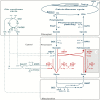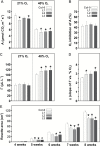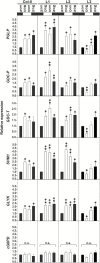High serine:glyoxylate aminotransferase activity lowers leaf daytime serine levels, inducing the phosphoserine pathway in Arabidopsis
- PMID: 28011718
- PMCID: PMC5441925
- DOI: 10.1093/jxb/erw467
High serine:glyoxylate aminotransferase activity lowers leaf daytime serine levels, inducing the phosphoserine pathway in Arabidopsis
Abstract
Serine:glyoxylate aminotransferase (SGAT) converts glyoxylate and serine to glycine and hydroxypyruvate during photorespiration. Besides this, SGAT operates with several other substrates including asparagine. The impact of this enzymatic promiscuity on plant metabolism, particularly photorespiration and serine biosynthesis, is poorly understood. We found that elevated SGAT activity causes surprisingly clear changes in metabolism and interferes with photosynthetic CO2 uptake and biomass accumulation of Arabidopsis. The faster serine turnover during photorespiration progressively lowers day-time leaf serine contents and in turn induces the phosphoserine pathway. Transcriptional upregulation of this additional route of serine biosynthesis occurs already during the day but particularly at night, efficiently counteracting night-time serine depletion. Additionally, higher SGAT activity results in an increased use of asparagine as the external donor of amino groups to the photorespiratory pathway but does not alter leaf asparagine content at night. These results suggest leaf SGAT activity needs to be dynamically adjusted to ensure (i) variable flux through the photorespiratory pathway at a minimal consumption of asparagine and (ii) adequate serine levels for other cellular metabolism.
Keywords: Arabidopsis thaliana; phosphoserine pathway; photorespiration; serine; serine biosynthesis; serine:glyoxylate aminotransferase.
© The Author 2016. Published by Oxford University Press on behalf of the Society for Experimental Biology.
Figures








Similar articles
-
Distinct photorespiratory reactions are preferentially catalyzed by glutamate:glyoxylate and serine:glyoxylate aminotransferases in rice.J Photochem Photobiol B. 2015 Jan;142:110-7. doi: 10.1016/j.jphotobiol.2014.11.009. Epub 2014 Dec 12. J Photochem Photobiol B. 2015. PMID: 25528301
-
Properties of serine:glyoxylate aminotransferase purified from Arabidopsis thaliana leaves.Acta Biochim Biophys Sin (Shanghai). 2008 Feb;40(2):102-10. doi: 10.1111/j.1745-7270.2008.00383.x. Acta Biochim Biophys Sin (Shanghai). 2008. PMID: 18235971
-
Arabidopsis thaliana ggt1 photorespiratory mutants maintain leaf carbon/nitrogen balance by reducing RuBisCO content and plant growth.Plant J. 2015 Sep;83(6):1005-18. doi: 10.1111/tpj.12945. Plant J. 2015. PMID: 26216646
-
Engineering photorespiration in chloroplasts: a novel strategy for increasing biomass production.Trends Biotechnol. 2007 Oct;25(10):437-40. doi: 10.1016/j.tibtech.2007.08.007. Epub 2007 Sep 17. Trends Biotechnol. 2007. PMID: 17870196 Review.
-
Molecular biology of the plastidic phosphorylated serine biosynthetic pathway in Arabidopsis thaliana.Amino Acids. 2001;20(3):243-59. doi: 10.1007/s007260170042. Amino Acids. 2001. PMID: 11354602 Review.
Cited by
-
Phosphoserine Aminotransferase1 Is Part of the Phosphorylated Pathways for Serine Biosynthesis and Essential for Light and Sugar-Dependent Growth Promotion.Front Plant Sci. 2018 Nov 20;9:1712. doi: 10.3389/fpls.2018.01712. eCollection 2018. Front Plant Sci. 2018. PMID: 30515188 Free PMC article.
-
Plant Glyoxylate/Succinic Semialdehyde Reductases: Comparative Biochemical Properties, Function during Chilling Stress, and Subcellular Localization.Front Plant Sci. 2017 Aug 14;8:1399. doi: 10.3389/fpls.2017.01399. eCollection 2017. Front Plant Sci. 2017. PMID: 28855911 Free PMC article.
-
Transcriptomic analysis of bakanae disease resistant and susceptible rice genotypes in response to infection by Fusarium fujikuroi.Mol Biol Rep. 2022 Dec;49(12):11959-11972. doi: 10.1007/s11033-022-07877-1. Epub 2022 Oct 21. Mol Biol Rep. 2022. PMID: 36271308
-
Nitric Oxide Turnover Under Hypoxia Results in the Rapid Increased Expression of the Plastid-Localized Phosphorylated Pathway of Serine Biosynthesis.Front Plant Sci. 2022 Jan 31;12:780842. doi: 10.3389/fpls.2021.780842. eCollection 2021. Front Plant Sci. 2022. PMID: 35173748 Free PMC article.
-
New Insight into Aspartate Metabolic Pathways in Populus: Linking the Root Responsive Isoenzymes with Amino Acid Biosynthesis during Incompatible Interactions of Fusarium solani.Int J Mol Sci. 2022 Jun 7;23(12):6368. doi: 10.3390/ijms23126368. Int J Mol Sci. 2022. PMID: 35742809 Free PMC article.
References
-
- Benstein RM, Ludewig K, Wulfert S, Wittek S, Gigolashvili T, Frerigmann H, Gierth M, Flügge UI, Krueger S. 2013. Arabidopsis phosphoglycerate dehydrogenase1 of the phosphoserine pathway is essential for development and required for ammonium assimilation and tryptophan biosynthesis. The Plant Cell 25, 5011–5029. - PMC - PubMed
-
- Bloom AJ. 2015. Photorespiration and nitrate assimilation: a major intersection between plant carbon and nitrogen. Photosynthesis Research 123, 117–128. - PubMed
MeSH terms
Substances
LinkOut - more resources
Full Text Sources
Other Literature Sources
Molecular Biology Databases

